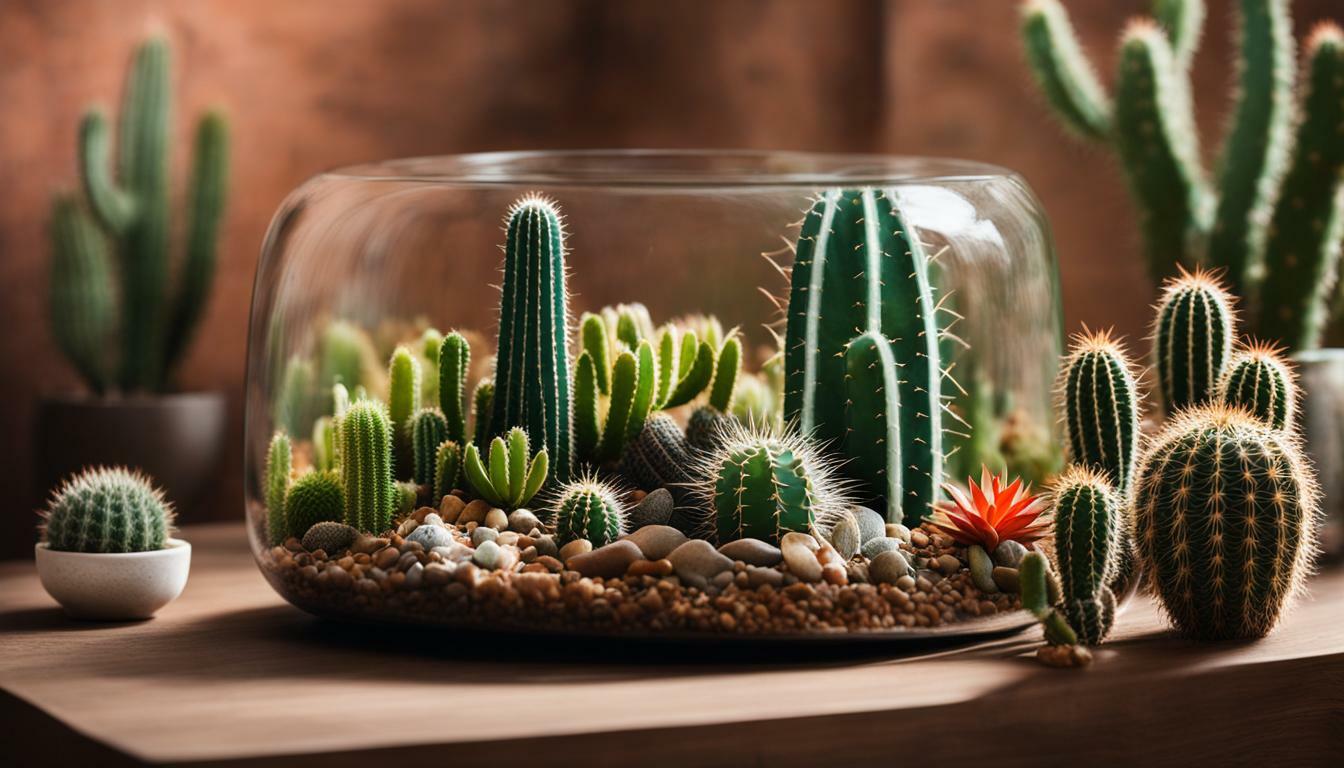Terrarium plants cacti are a fascinating and low-maintenance addition to any indoor space. These unique plants offer a creative way to bring greenery into your home while requiring minimal care. In this comprehensive guide, we will delve into everything you need to know about terrarium plants cacti. From caring for these plants to creating stunning terrarium setups, we’ll provide you with all the information you need to grow and nurture your own mini ecosystems.
- Terrarium plants cacti are a low-maintenance addition to any indoor space.
- There are two main types of terrariums: open and closed.
- Closed terrariums are suitable for tropical plants, while open terrariums are ideal for arid species like cacti and succulents.
- Cacti are popular for terrariums due to their unique shapes and low maintenance requirements.
- Proper care, including providing the right amount of light, water, and ventilation, is essential for the health of terrarium plants cacti.
Understanding Terrariums: Open vs. Closed
There are two main types of terrariums: open and closed, each offering a unique environment for your plants. Open terrariums provide a drier atmosphere, making them suitable for arid species like cacti and succulents. These plants thrive in well-draining soil and require minimal watering. Closed terrariums, on the other hand, create a more humid environment, perfect for tropical plants that enjoy high moisture levels. These terrariums can support a wide range of plants, including ferns, peperomia, and air plants.
Open Terrariums
In open terrariums, the lack of a sealed environment allows for better air circulation and reduces moisture buildup, preventing the risk of root rot. This makes them a great choice for plants that prefer drier conditions. Open terrarium plants, such as echeveria, haworthia, and string of pearls, are known for their ability to store water in their leaves and tolerate periods of drought. These plants, with their unique shapes and vibrant colors, can add visual interest to your terrarium display.
Closed Terrariums
Closed terrariums are an enclosed environment, creating a mini greenhouse that retains moisture and humidity. This environment is ideal for plants that crave high humidity, such as ferns, peperomia, and air plants. The humidity inside a closed terrarium allows these plants to thrive, as it mimics their natural habitat. The enclosed setup also helps to conserve water, reducing the need for frequent watering. These lush and green terrarium setups can bring a tropical touch to your indoor space.
No matter which type of terrarium you choose, it’s important to select plants that are well-suited for the specific environment. By understanding the differences between open and closed terrariums, you can create a thriving mini ecosystem that showcases the beauty and diversity of terrarium plants.
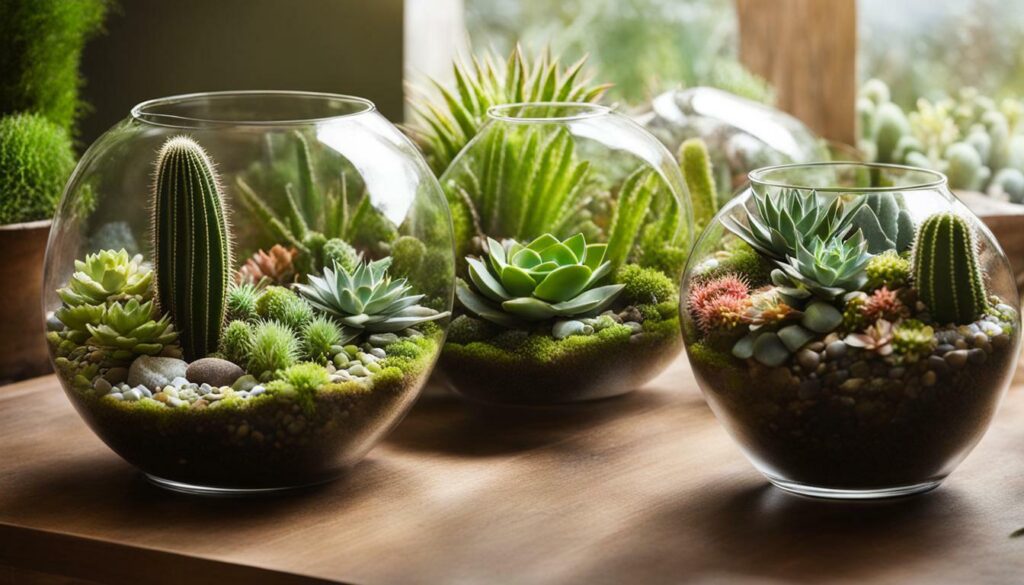
When creating a closed terrarium, you’ll want to choose plants that can thrive in high humidity environments. These types of terrariums are enclosed, creating a mini greenhouse effect where moisture is trapped inside. Here are some of the best plants that can thrive in closed terrarium setups:
- Ferns: Ferns are excellent choices for closed terrariums as they thrive in high humidity and lower light conditions. They come in various shapes and sizes, adding a lush and tropical feel to your terrarium. Some popular fern species for closed terrariums include maidenhair ferns and button ferns.
- Peperomia: Peperomia plants are known for their attractive foliage and their ability to tolerate high humidity. They come in a range of leaf shapes and colors, making them a versatile and visually appealing choice for closed terrariums.
- Air Plants: Air plants, also known as Tillandsia, are unique plants that don’t require soil to grow. They absorb moisture from the air and can thrive in the high humidity of closed terrariums. These plants come in various shapes and sizes, adding a touch of whimsy and uniqueness to your terrarium.
It’s important to choose plants that have similar care requirements and growth habits when creating a closed terrarium. This ensures that they can coexist harmoniously and thrive in the enclosed environment. Additionally, consider the size of the plants and their growth potential, as you want them to fit well within the terrarium and not outgrow the space.
“Closed terrariums provide the perfect environment for plants that love high humidity. By choosing the right plants, you can create a beautiful, self-sustaining ecosystem within your terrarium.” – Terrarium Enthusiast
Here is a table summarizing the best plants for closed terrariums:
| Plant | Light Requirements | Watering Needs | Size |
|---|---|---|---|
| Ferns | Low to medium light | Moderate watering | Varies depending on species |
| Peperomia | Low to medium light | Low to moderate watering | Varies depending on species |
| Air Plants (Tillandsia) | Indirect light | Mist or soak once a week | Varies depending on species |
With these plants, you can create a beautiful and thriving closed terrarium that will bring a touch of nature into your indoor space. Remember to monitor the humidity levels, provide adequate light, and water the plants as needed to ensure their health and vitality.
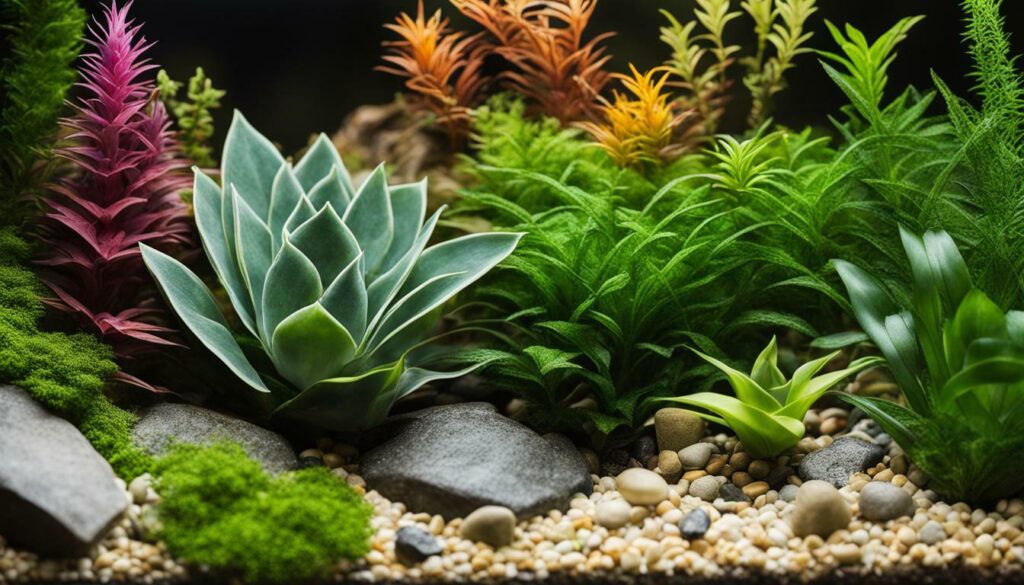
If you’re planning to create an open terrarium, you’ll need plants that can tolerate drier conditions. Open terrariums provide a drier environment compared to closed terrariums, making them suitable for arid species like cacti and succulents. These plants have adapted to survive in harsh desert climates and can thrive in the limited moisture and increased airflow of an open terrarium.
One popular open terrarium plant is the echeveria, a succulent known for its rosette-shaped leaves in a variety of colors. From pale green to deep purple, echeverias add a pop of color and texture to your terrarium. Another excellent choice is the haworthia, which features striking geometric patterns on its leaves and is highly drought-tolerant.
A unique addition to an open terrarium is the string of pearls (Senecio rowleyanus), also known as the bead plant. This trailing succulent has round, bead-like leaves that cascade over the sides of the terrarium, creating a visually stunning display. Its low water requirements make it a perfect choice for an open terrarium.
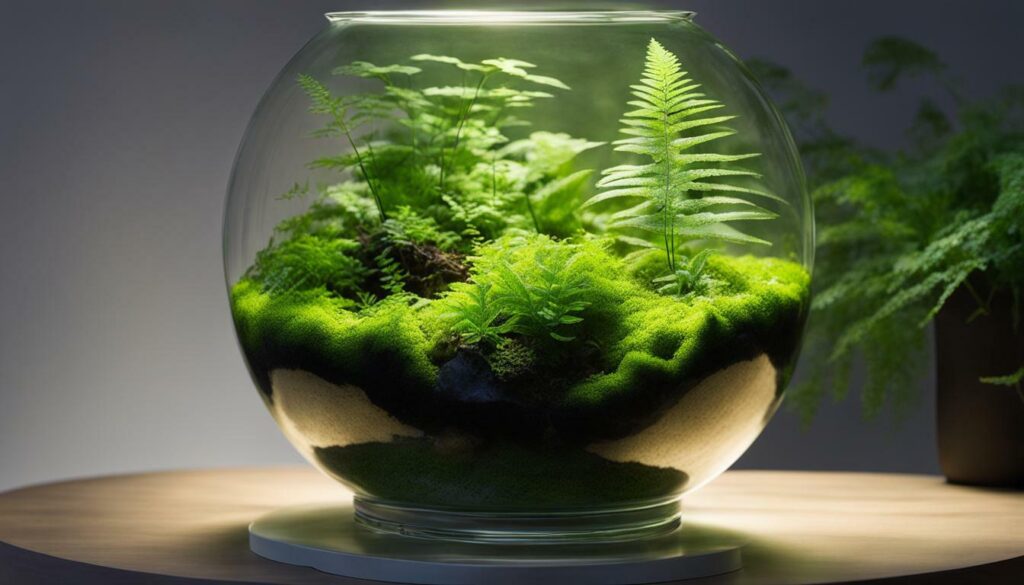
| Plant | Description | Light Requirements | Watering Frequency |
|---|---|---|---|
| Echeveria | Rosette-shaped leaves in various colors | Full sun to bright indirect light | Drought-tolerant, water when soil is completely dry |
| Haworthia | Geometric leaf patterns | Bright indirect light | Sparingly, allow soil to dry between waterings |
| String of Pearls | Trailing succulent with bead-like leaves | Bright indirect light | Infrequent watering, allow soil to dry out |
These open terrarium plants not only thrive in drier conditions but also add charm and visual interest to your terrarium setup. Combine them with other succulents or decorative elements to create a unique and eye-catching display.
Why Cacti are Perfect for Terrariums
Cacti offer a perfect combination of visual appeal and ease of care, making them an excellent choice for terrariums. Their unique shapes and textures create an eye-catching display, adding a touch of desert charm to your miniature ecosystem. Whether you’re a beginner or an experienced gardener, cacti are a versatile option that can thrive in various terrarium setups.
One of the main reasons why cacti are ideal for terrariums is their low maintenance requirements. These resilient plants have adapted to survive in harsh desert conditions, making them highly tolerant of drought and neglect. This means that even if you forget to water them occasionally, they’ll still thrive in your terrarium. Additionally, cacti require minimal pruning, making them a hassle-free choice for those who want to enjoy the beauty of nature without much effort.
Another advantage of cacti in terrariums is their slow growth rate. Unlike other plants that may quickly outgrow their container, cacti maintain a compact size for a long time. This means that your terrarium will remain visually appealing and well-balanced, without the need for frequent replanting. Their ability to stay small and compact makes them an excellent option for terrarium enthusiasts who want to create long-lasting and low-maintenance displays.
When selecting cacti for your terrarium, choose varieties that are suited for the size of your container and the specific conditions of your terrarium. Some popular options include Echinocactus grusonii (Golden Barrel Cactus), Mammillaria species, and Gymnocalycium mihanovichii (Moon Cactus). These cacti come in a variety of shapes and colors, allowing you to create a visually striking terrarium that reflects your personal style.
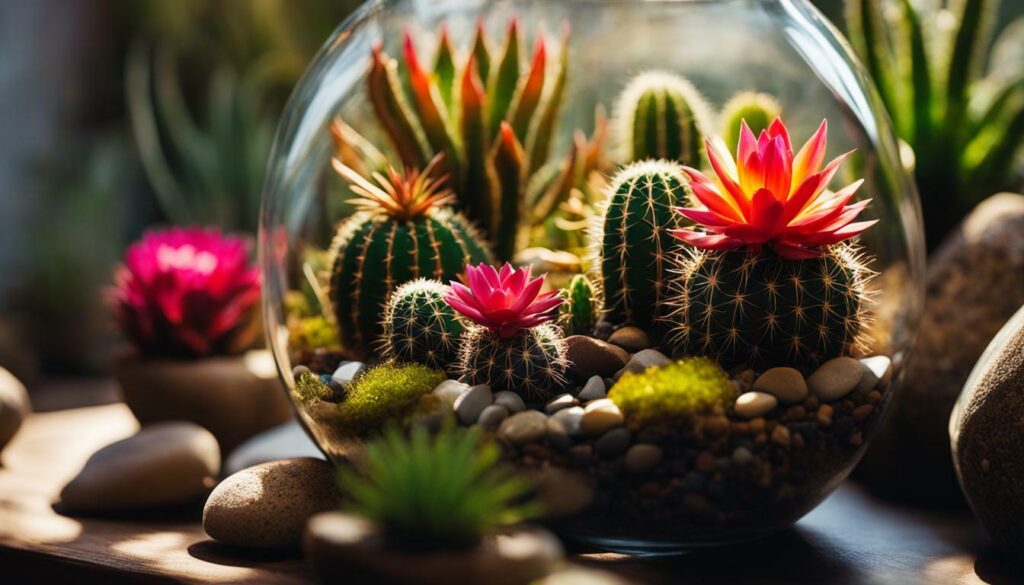
| Cacti | Watering | Light | Temperature |
|---|---|---|---|
| Echinocactus grusonii (Golden Barrel Cactus) | Infrequent, deep watering | Full sun | 60-80°F (15-27°C) |
| Mammillaria species | Sparse watering | Bright, indirect light | 60-75°F (15-24°C) |
| Gymnocalycium mihanovichii (Moon Cactus) | Occasional watering | Bright, indirect light | 60-75°F (15-24°C) |
Caring for Terrarium Plants
To ensure your terrarium plants thrive, it’s important to provide them with the right conditions and care. Terrarium plants are unique and require specific attention to ensure their health and longevity. Here are some key aspects to consider when caring for your terrarium plants cacti:
Light:
Light is essential for the growth of terrarium plants. Place your terrarium in a well-lit area, but avoid direct sunlight, as it can cause the plants to burn. Different types of terrarium plants have different light requirements, so make sure to research the specific needs of your plants.
Water:
Proper watering is crucial for terrarium plants. Overwatering can lead to root rot, while underwatering can cause the plants to wither. The best way to water your terrarium is to mist the plants with a spray bottle, ensuring that the soil is evenly moist but not waterlogged. Monitor the moisture levels regularly and adjust your watering schedule accordingly.
Ventilation:
Good airflow is essential for preventing mold and promoting healthy growth in your terrarium. Open terrariums naturally provide more airflow, but closed terrariums may require occasional ventilation. You can achieve this by slightly opening the lid or removing it for a short period every few days.
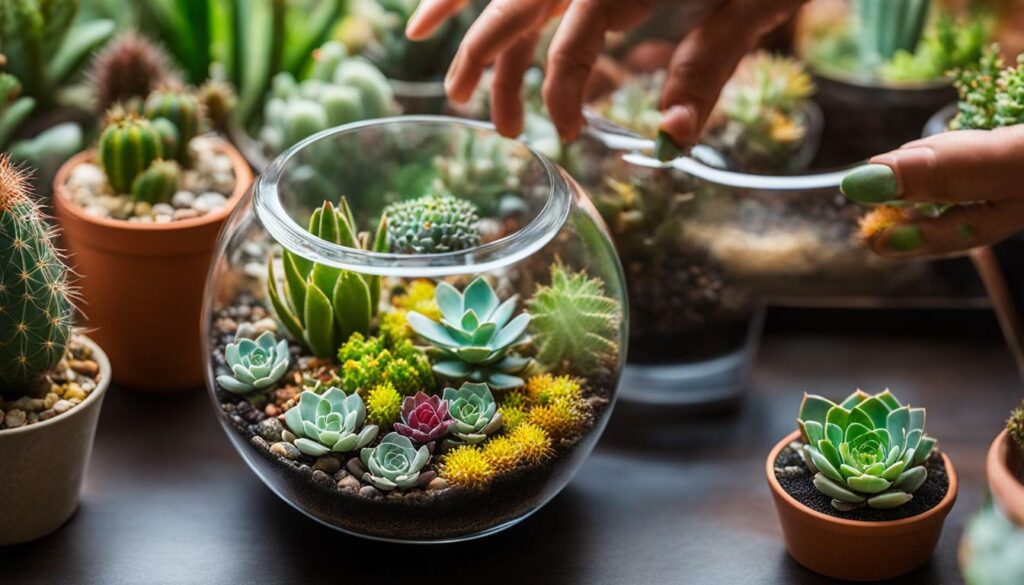
Tip: Adding activated charcoal to the bottom layer of your terrarium can help to reduce odors and keep the air fresh.
Pruning and Cleaning:
Regular pruning will help maintain the shape and size of your terrarium plants. Trim away any dead or yellow leaves, and remove any plants that have outgrown the terrarium. Additionally, clean the glass or container of the terrarium to remove any dust or dirt that may obstruct light from reaching the plants.
| Aspect | Closed Terrarium | Open Terrarium |
|---|---|---|
| Light | Indirect, bright light | Bright, direct sunlight |
| Watering | Mist and keep soil moist | Allow soil to dry between watering |
| Humidity | High humidity | Low to medium humidity |
| Airflow | Minimal ventilation | Natural airflow |
Remember, each terrarium plant has unique requirements, so it’s important to research and understand the specific needs of the plants you choose. By providing the right conditions of light, water, ventilation, and regular maintenance, you can create a thriving terrarium ecosystem that adds beauty and tranquility to your indoor space.
Creative Terrarium Plant Ideas
Let your creativity flow with these inspiring terrarium plant ideas that will elevate your indoor space. Terrarium plants offer a unique opportunity to create miniature ecosystems that bring a touch of nature into your home. Whether you prefer a lush green landscape or a desert-inspired display, there are endless possibilities to explore.
To add a touch of elegance to your terrarium, consider incorporating unique cacti species. With their striking shapes and textures, cacti can become the focal point of your mini garden. Try combining different types of cacti, such as the prickly pear cactus with its vibrant pads or the barrel cactus with its spherical form. These plants not only add visual interest but also require minimal care, making them perfect for beginner terrarium enthusiasts.
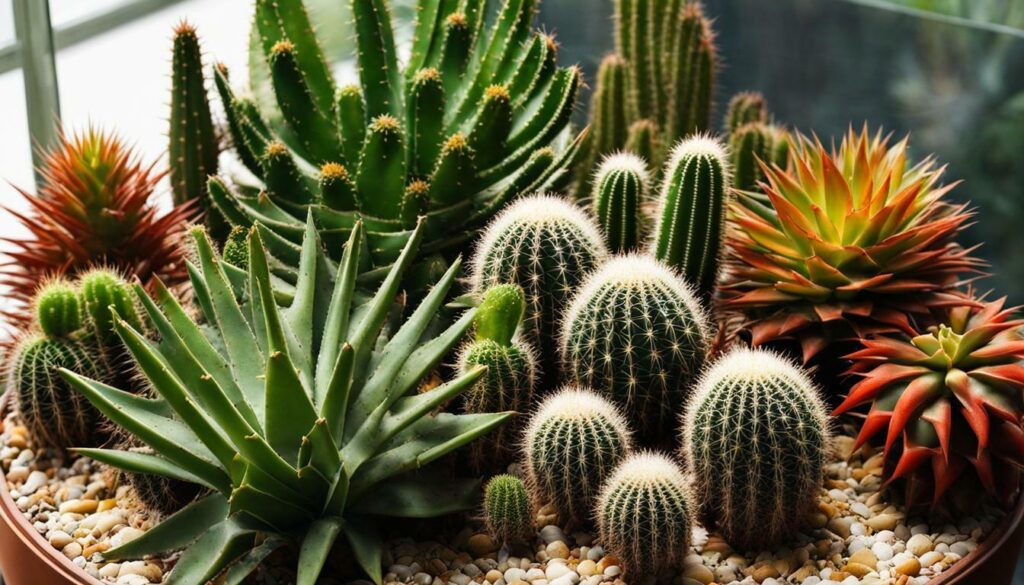
For a more tropical feel, you can incorporate ferns into your terrarium. With their delicate fronds and rich green color, ferns create a lush and vibrant atmosphere. Consider using a mixture of different fern species, such as the maidenhair fern or the bird’s nest fern, to add variety and texture to your terrarium. These plants thrive in high humidity environments, making them ideal for closed terrarium setups.
To create a whimsical and enchanting terrarium, you can include air plants. These unique plants do not require soil and can be attached to driftwood, rocks, or even suspended in the air. Air plants come in a variety of shapes and sizes, allowing you to experiment with different arrangements and create a truly captivating display. Incorporate them alongside other plants or create a standalone air plant terrarium for a truly mesmerizing effect.
Table: Terrarium Plant Ideas
| Plant | Light Requirements | Watering Frequency | Special Care |
|---|---|---|---|
| Cactus | Full sun | Low | Avoid overwatering |
| Fern | Moderate indirect light | Regular | Maintain high humidity |
| Air Plant | Indirect light | Weekly misting | No soil required |
With these creative terrarium plant ideas, you can design a stunning miniature world that reflects your personal style. Experiment with different combinations, textures, and heights to create a visually captivating display. Remember to consider the light and humidity requirements of each plant and provide them with the care they need to flourish. Let your terrarium become a source of inspiration and a living work of art in your home.
Beginner-Friendly Terrarium Plants
Embark on your terrarium journey with confidence by selecting these beginner-friendly plants that are perfect for cacti enthusiasts. These plants are not only easy-to-care-for but also add a touch of beauty and greenery to your terrarium setup.
One excellent choice for beginners is the Haworthia, a small succulent that features attractive rosette-shaped leaves. Haworthias are known for their tolerance to low light conditions, making them ideal for indoor terrariums. They require minimal watering and can thrive in arid environments, making them a great fit for open terrariums.
Another beginner-friendly option is the Echeveria, a stunning succulent with thick, fleshy leaves that form a rosette shape. Echeverias come in a variety of colors and textures, adding visual interest to your terrarium. These plants prefer bright, indirect light and require well-draining soil. With proper care, Echeverias can thrive in both open and closed terrariums.
If you’re looking for a unique addition to your terrarium, consider the String of Pearls. This trailing succulent features round, bead-like leaves that cascade over the edges of the container, creating a whimsical effect. String of Pearls prefers bright, indirect light and well-draining soil. It’s a great choice for both open and closed terrariums, adding a touch of elegance to your miniature ecosystem.
| Plant | Light Requirements | Watering Frequency | Preferred Terrarium Type |
|---|---|---|---|
| Haworthia | Low to medium light | Once every 2-3 weeks | Open terrarium |
| Echeveria | Bright, indirect light | Once every 1-2 weeks | Open or closed terrarium |
| String of Pearls | Bright, indirect light | Once every 2-3 weeks | Open or closed terrarium |
With these beginner-friendly plants, you can create a stunning terrarium display that will thrive with minimal effort. Just remember to provide the right amount of light and water, and choose a terrarium type that suits the plant’s needs. Happy terrarium gardening!
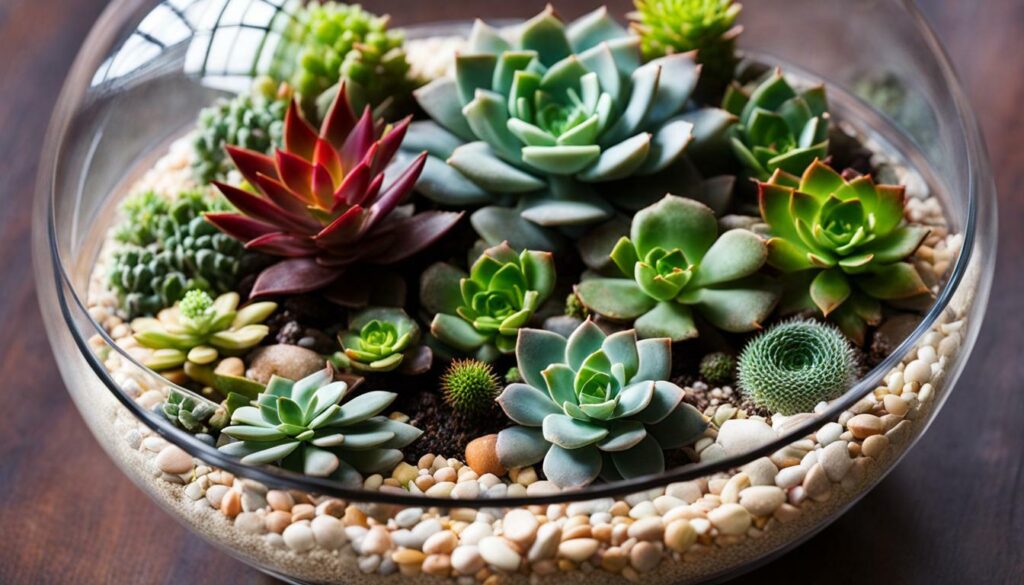
Terrarium plants cacti are a captivating addition to any home, allowing you to create beautiful miniature worlds with minimal effort. These diverse plants offer endless possibilities for creating stunning terrarium setups that can add a touch of nature to your indoor space.
When choosing the right terrarium plants, it’s important to consider the type of terrarium you have. Closed terrariums, with their high humidity, are perfect for tropical plants like ferns, peperomia, and air plants. On the other hand, open terrariums, with their drier environment, are best suited for arid species such as cacti and succulents like echeveria, haworthia, and string of pearls.
Cacti, in particular, are a popular choice for terrariums due to their unique shapes and low maintenance requirements. They can thrive in a variety of terrarium setups and add a touch of character to your miniature ecosystem.
Proper care is essential for the health and longevity of your terrarium plants cacti. Provide them with the right amount of light, water, and ventilation, and don’t forget to prune and clean them regularly to maintain their appearance. With a little attention and care, you can enjoy the beauty of these low-maintenance plants for years to come.
In conclusion, terrarium plants cacti offer a creative and low-maintenance way to bring greenery into your indoor space. Whether you’re a beginner or an experienced gardener, these plants provide an opportunity to create stunning and unique miniature ecosystems that will captivate and inspire.
Are Tropical Plants Suitable for Terrariums with Cacti?
Yes, tropical terrarium plants for home can coexist with cacti in the same enclosure. While cacti thrive in arid conditions, certain tropical plants such as bromeliads and air plants can also thrive in the same environment, as long as proper care is taken to ensure their respective needs are met.
FAQ
What are the two main types of terrariums?
The two main types of terrariums are open and closed.
What plants are suitable for closed terrariums?
Plants that thrive in high humidity, such as ferns, peperomia, and air plants, are ideal for closed terrariums.
What plants are suitable for open terrariums?
Open terrariums are suitable for arid species like cacti and succulents, such as echeveria, haworthia, and string of pearls.
Why are cacti perfect for terrariums?
Cacti are popular for terrariums due to their unique shapes and low maintenance requirements.
How do I care for terrarium plants?
Proper care includes providing the right amount of light, water, and ventilation, as well as regular pruning and cleaning.
Do you have any creative terrarium plant ideas?
Yes, we have a section dedicated to creative terrarium plant ideas, including unique cacti species.
Are there any beginner-friendly terrarium plants?
Yes, we provide recommendations for beginner-friendly terrarium plants, including easy-to-care-for cacti varieties.

